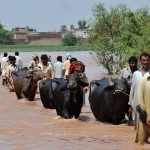- DETERRENCE: Prompt global strike: China and the spear
- DPRK: N. Korea mum on fresh U.S. dialogue offer: sources
- GOVERNANCE AND CIVIL SOCIETY: With rural Japan shrinking and aging, a small town seeks to stem the trend
- CLIMATE CHANGE ADAPTATION: Challenges of urban resilience in India
- AUSTRAL PEACE AND SECURITY: Spooks admit it in private: Snowden has made them rethink their methods
 DETERRENCE: Prompt global strike: China and the spear, Lora Saalman, The Asia-Pacific Center for Security Studies (April 2014) [PDF, 0.4MB]
DETERRENCE: Prompt global strike: China and the spear, Lora Saalman, The Asia-Pacific Center for Security Studies (April 2014) [PDF, 0.4MB]
The PLA exhibits combat weaknesses in land, air, maritime, space, and electromagnetic domains. It also faces difficulties mastering, training for, and integrating new and complex weapons. To overcome these deficits, and to counter the risk that the US may achieve pre-emptive capability against its nuclear forces, China may try to develop new, advanced long, range precision-guided weapons that target weak links, especially ISR critical to US weaponry. Although re-affirmed in its latest Defense White Paper, China’s No First Use policy is not immutable.
- China’s YJ-18 supersonic anti-ship cruise missile: America’s nightmare? Lyle J. Goldstein, The National Interest (1 June 2015)
- Strategic warning and China’s nuclear posture, what the 2015 Defense White Paper tells us about China’s nuclear policy, Tong Zhao, The Diplomat (28 May 2015)
- China’s incomplete military transformation assessing the weaknesses of the People’s Liberation Army (PLA), Michael Chase et al, RAND (February 2015) [PDF, 6.4MB]
 DPRK: N. Korea mum on fresh U.S. dialogue offer: sources, Chang Jae-soon, Yonhap News Agency (1June 2015)
DPRK: N. Korea mum on fresh U.S. dialogue offer: sources, Chang Jae-soon, Yonhap News Agency (1June 2015)
North Korea’s spate of executions (nominally ordered by Kim Jong-un) should be understood in the context of systemic and internal weaknesses – not strengths. Moreover, until North Korea resolves their internal dialectic conflicts they will generally not respond to external stimuli and when they do, they will only react to the domestic effects of the external stimuli. However, the leadership sees benefits from engaging in selected health activities which might threaten internal stability and selected cultural events which strengthen North Korea’s evolving metanarratives.
- Talk to Kim Jong-un even as he kills his way to power in North Korea, Doug Bandow, Cato Institute (1 June 2015)
- (LEAD) Koreas set for 6-month historical project, Global Post (30 May 2015)
- South Korea to help North Korea screen MERS virus at Kaesong, Elizabeth Shim, UPI (4 June 2015)
 GOVERNANCE AND CIVIL SOCIETY: With rural Japan shrinking and aging, a small town seeks to stem the trend, Anna Fifield, Washington Post (26 May 2015)
GOVERNANCE AND CIVIL SOCIETY: With rural Japan shrinking and aging, a small town seeks to stem the trend, Anna Fifield, Washington Post (26 May 2015)
With Japan’s rural population declining and communities disappearing, a small village is looking to reverse the trend by bringing in startups from restaurants to IT. The ROK is responding to its aging rural population needs by supporting public transportation initiatives, which have seen increases in the number of elderly engaging in community life, and legal services previously inaccessible.
- Aging Kamiyama hopes to rejuvenate with IT startups, Atsushi Tomoe, Kyodo (1 January 2014)
- Isolated, aging villagers enjoying the ride, Lee Tae-kyung, Joongang Ilbo (9 May 2015)
- Village lawyer system expanding to settle more rural disputes, Ahn Gwan-ok, Hankyoreh (29 May 2015)
 CLIMATE CHANGE ADAPTATION: Challenges of urban resilience in India, Southasiadisasters.net, All India Disaster Mitigation Institute (AIDMI), no.128 (March 2015) [845 KB, PDF]
CLIMATE CHANGE ADAPTATION: Challenges of urban resilience in India, Southasiadisasters.net, All India Disaster Mitigation Institute (AIDMI), no.128 (March 2015) [845 KB, PDF]
Weak institutional frameworks and gross social inequalities in India make the urban centers of the country particularly susceptible to the adverse impacts of disasters. Climate change has added another level of complexity to the mire of existing vulnerabilities. In this context, this issue attempts to explore the underlying facts, observable trends and the projected impacts of these urban risks and their implications on urban resilience in India.
- Climate change in the context of India, Asian Cities Climate Change Resilience Network, 2015
- Urban climate change resilience: a synopsis, Asian Development Bank (2014) [2.54 MB, PDF]
 AUSTRAL PEACE AND SECURITY: Spooks admit it in private: Snowden has made them rethink their methods, Duncan Campbell, The Guardian (2 June 2015)
AUSTRAL PEACE AND SECURITY: Spooks admit it in private: Snowden has made them rethink their methods, Duncan Campbell, The Guardian (2 June 2015)
With previously unimaginable levels of surveillance of global electronic communications, leaders of Five Eyes agencies themselves ask whether “Snowden’s actions were an inevitable, and perhaps necessary, counterbalance to excesses of intelligence collection after 9/11”. Their capacity to listen to the world’s 200-plus communications satellites has more than quadrupled since 2001. FVEY cooperative research gives the minor players in the Anglophone SIGINT club – Australia, Canada and New Zealand – key roles in global surveillance.
- “Torus”: has one word in a Snowden leak revealed a huge expansion in surveillance?’ Duncan Campbell, wired.co.uk (28 May 2015)
- Pine Gap’s new spy role revealed, Philip Dorling, Sydney Morning Herald (31 May 2015)
- Australia a leader in hacking mobile phones, Snowden document reveals, Philip Dorling, Sydney Morning Herald (22 May 2015)
The Nautilus Peace and Security Weekly Report presents articles and full length reports each week in six categories: Austral security, nuclear deterrence, energy security, climate change and security, the DPRK, climate change adaptation and governance and civil society. Our team of contributors carefully select items that highlight the links between these themes and the three regions in which our offices are found — North America, Northeast Asia, and the Austral-Asia region.
Subscribe to NAPSNet to receive free weekly email reports.
- Editor: Arabella Imhoff
Contributors:
- Deterrence: Peter Hayes
- DPRK: Roger Cavazos
- Governance and Civil Society: Dyana Mardon
- Climate Change Adapation: Saleem Janjua
- Austral Peace and Security: Richard Tanter

